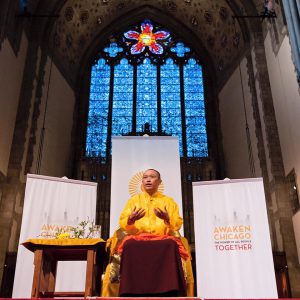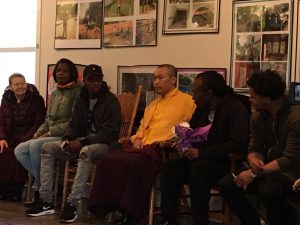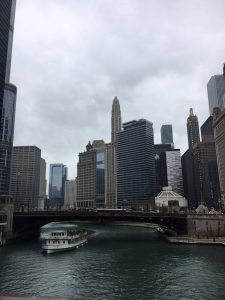Monday
Featured StoriesChicago, Four Years Beyond Peace
From Imagining Peace four years ago to Awakening Chicago this first week of May, continuing the conversation with Sakyong Mipham Rinpoche
by Debra Hiers
 When Sakyong Mipham Rinpoche addressed several hundred participants in Rockefeller Chapel Friday evening, he first expressed his gratitude for the work being done in Chicago over the past four years–since he first came to this city for the Imagine Peace conference. He also reflected on the continuing hardships and challenges in the world today, citing not only the increasing level of violence in cities like Chicago, but also the situation with Syrian refugees in Europe, as well as the aftermath of the earthquake in Nepal.
When Sakyong Mipham Rinpoche addressed several hundred participants in Rockefeller Chapel Friday evening, he first expressed his gratitude for the work being done in Chicago over the past four years–since he first came to this city for the Imagine Peace conference. He also reflected on the continuing hardships and challenges in the world today, citing not only the increasing level of violence in cities like Chicago, but also the situation with Syrian refugees in Europe, as well as the aftermath of the earthquake in Nepal.
The fact that we don’t have ready answers to these problems is no reason to turn away from them. As the Sakyong said: “I myself am challenged as to what to do in this time. … Humanity is at a crossroads.” Now is the time to connect with our innate wisdom, to determine who and what we are, as a city, as a people, and as individuals.
We hear so many times of how deeply flawed we are as human beings, how the governments and politicians can’t be trusted, how greed rules the world. What we are trying to do here instead is “to look at and challenge the existing narrative.” There is a deep level of questioning. On the one hand it seems extremely complicated, but on the other it is actually quite simple: “One of the basic approaches is to regard ourselves and humanity as basically good.”
It comes down to trusting in our own innate wisdom, wisdom that is gleaned from experience. And it takes courage and bravery. The Sakyong said that sometimes, “We don’t want to wake up because we don’t want to ‘see’ things.” To wake up is to challenge the narrative, and to claim one’s basic goodness. If an individual can wake up, then so can a community. As Rinpoche put it, “The city of Chicago itself is like a person, and that person is trying to wake up.”
Building relationships is a key ingredient in transforming society. We start with our relationship to ourselves. By accepting ourselves, we can accept others. “When we feel we are worthy, there is a quality of strength and dignity,” and we can extend that feeling, those qualities, to others. We can join hands, come together, and change the narrative by doing the simple things. “Even the way we look at someone matters,” said the Sakyong. “The dignity we experience ourselves, we give to others. That confidence is powerful.”
Throughout the Sakyong’s talk he affirmed and reminded us of the need for self-acceptance. We can’t change our world without it. An important tool in working with ourselves is being able to self-reflect and keep our cool in stressful situations. He suggested that we ask ourselves: How are you, how do you feel? Be the change you want to see, because we can’t convince others to change if we are not manifesting that change ourselves. So we have to set the example.
 In his talk, the Sakyong outlined four stages to developing community: Stage One is the phase of feeling, gentleness and friendliness. “If you live in a city that is not friendly, it is difficult to feel connected so it takes strength to feel, strength to be kind.” Stage Two is engaging what Tibetans call lungta or windhorse. “When you tap into your own basic goodness, there is power to make change.” This is the power of compassion, the power of virtue. “We have to live our lives according to the principles we admire.” And most importantly, we have to engage with joy! Stage Three is relating with unconditionality. “We don’t know what is going to happen,” said the Sakyong. Can you be OK with this? Things might get better, but they also might get a lot worse. Can you be in the space of not knowing and still keep your strength? In doing this we establish a sense of equanimity. And through equanimity we build trust.
In his talk, the Sakyong outlined four stages to developing community: Stage One is the phase of feeling, gentleness and friendliness. “If you live in a city that is not friendly, it is difficult to feel connected so it takes strength to feel, strength to be kind.” Stage Two is engaging what Tibetans call lungta or windhorse. “When you tap into your own basic goodness, there is power to make change.” This is the power of compassion, the power of virtue. “We have to live our lives according to the principles we admire.” And most importantly, we have to engage with joy! Stage Three is relating with unconditionality. “We don’t know what is going to happen,” said the Sakyong. Can you be OK with this? Things might get better, but they also might get a lot worse. Can you be in the space of not knowing and still keep your strength? In doing this we establish a sense of equanimity. And through equanimity we build trust.
Stage Four is being in a state of playfulness, of possibility, of imagination, of creation as opposed to destruction. This is a quality of undeniable aliveness. And we are not talking about playfulness as frivolity, but playfulness in the sense of celebration, art, and culture. It takes this kind of holistic approach to build community. We also have to accept that challenges and pain are just part of the journey, part of “the legacy of life.” If we can embrace all of life with an open curiosity, we can “shift the social paradigm,” and we can realize that “It’s not just about getting along, but flourishing. Peace is not the absence of struggle, but the power of possibility.” It is “dynamic and sustaining.”
Based on the transforming principles of the Shambhala Buddhist teachings that the Sakyong received from his father Chogyam Trungpa Rinpoche, creating a sane society based on basic goodness is possible. Tonight, as we leave the talk, the question we take with us is this: “How do we harness this goodwill that has brought us together?” It is not by accident that we are here.
Debra Hiers is a freelance writer and editor currently based in Atlanta, and has been involved with Shambhala for about two decades.


















May 4, 2016
Reply
Excellent talk…pithy useful points for people on building community. Thanks for sharing!